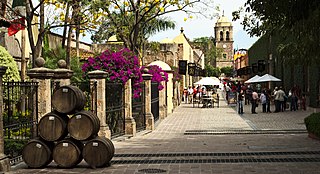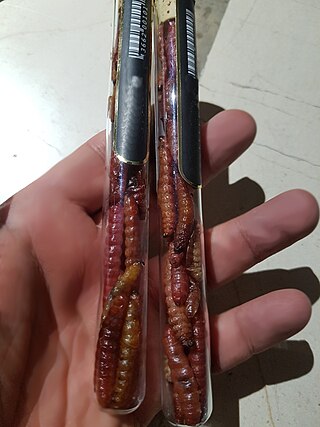
Tequila is a distilled beverage made from the blue agave plant, primarily in the area surrounding the city of Tequila 65 km (40 mi) northwest of Guadalajara, and in the Jaliscan Highlands of the central western Mexican state of Jalisco.

Mezcal, sometimes spelled mescal, is a distilled alcoholic beverage made from any type of agave. The word mezcal comes from Nahuatl mexcalli, which means "oven-cooked agave", from metl and ixcalli. Traditionally the word "mezcal" has been used generally in Mexico for all agave spirits and it continues to be used for many agave spirits whether these spirits have been legally certified as "mezcal" or not.

Agave americana, commonly known as the century plant, maguey, or American aloe, is a flowering plant species belonging to the family Asparagaceae. It is native to Mexico and the United States, specifically Texas. This plant is widely cultivated worldwide for its ornamental value and has become naturalized in various regions, including Southern California, the West Indies, South America, the Mediterranean Basin, Africa, the Canary Islands, India, China, Thailand, and Australia.

Agave tequilana, commonly called blue agave or tequila agave, is an agave plant that is an important economic product of Jalisco, Mexico, due to its role as the base ingredient of tequila, a popular distilled beverage. The high production of sugars named agavins, mostly fructose, in the core of the plant is the main characteristic that makes it suitable for the preparation of alcoholic beverages.

Santiago de Tequila is a Mexican town and municipality located in the state of Jalisco about 60 km from the city of Guadalajara. Tequila is best known as being the birthplace of the drink that bears its name, "tequila," which is made from the blue agave plant, native to this area. The heart of the plant contains natural sugars and was traditionally used to make a fermented drink. After the Spanish arrived, they took this fermented beverage and distilled it, producing the tequila known today. The popularity of the drink and the history behind it has made the town and the area surrounding it a World Heritage Site. It was also named a "Pueblo Mágico" in 2003 by the Mexican federal government.
Jose Cuervo is the best-selling brand of tequila, selling a fifth of the tequila consumed worldwide.

Patrón is a brand of tequila products founded by John Paul Dejoria and Martin Crowley.

Dos Lunas is a line of 100% blue agave tequilas produced in Guadalajara, Jalisco, Mexico, by Dos Lunas Spirits, LLC, headquartered in El Paso, Texas. The brand has the first triple-distilled silver tequila, a month aged Reposado, 18 month aged Añejo and 10 year old Extra Añejo.

The Norma Oficial Mexicana, abbreviated NOM, is the name of each of a series of official, compulsory standards and regulations for diverse activities in Mexico. They are more commonly referred to as NOMs or normas.

Don Julio is a brand of tequila produced in Mexico. It is the largest brand in value and eighth largest in volume. Its owned by the British-based multinational alcoholic beverage maker Diageo. It is distilled, manufactured and bottled by Tequila Don Julio, S.A. de C.V. from its corporate facility in the Colonia El Chichimeco district, in the city of Atotonilco El Alto, Jalisco, Mexico.

El Tesoro is a brand of tequila produced at a distillery in Jalisco, Mexico, where the family that founded the distillery is still involved in the business. In the United States, the brand is marketed by Beam Suntory. The producer claims to use labor-intensive traditional methods for making the tequila.

Sauza Tequila Import Company is a producer of tequila located in Tequila, a municipality of the state of Jalisco, Mexico. It was founded in 1873 when Don Cenobio Sauza started La Perseverancia distillery. Sauza Tequila Import Company is owned by Beam Suntory, headquartered in Chicago, Illinois. Their products include Sauza, Conmemorativo, Hornitos and Tres Generaciones.

Olmeca Tequila is a tequila produced in Jalisco, Mexico. Olmeca is owned by the Pernod Ricard Group. There are three tequilas that Olmeca produces: Olmeca, Olmeca Altos, and Olmeca Tezón.

Tres Agaves is a brand of organic 100% de Agave Tequila and Margarita mixes. The Tequila is produced at Tres Agaves' distillery in the town of Amatitán located in Jalisco, Mexico.

Tequila Herradura is a tequila distillery located in Amatitán, Jalisco, Mexico. It was formally founded in 1870 by Aurelio López and the business remained in the family for over 125 years. Today it is owned by US beverage maker Brown-Forman, but the tequila is still made in the same place and facilities under a Mexican subsidiary. Tequila products sold under the Herradura name are 100% agave. The company makes other tequila products, such as El Jimador, which is the best-selling tequila in Mexico, as well as New Mix, a tequila and grapefruit soda beverage. Since its acquisition by Brown-Forman, Herradura has had many promotional efforts in Mexico and the United States, including inviting artists to use tequila barrels as the bases for art pieces, which are then displayed and auctioned off for charity.
Agave Wine originates from Mexico. It is a fortified wine made from fermented blue agave, and fortified by being blended with blanco tequila. It is similar to tequila, in that it is harvested from the same plant. Although the two alcoholic beverages come from the weber blue agave plant, the drinks have similar, but different flavors. Agave wine has a much lower alcohol content and can be sold by vendors in the United States without an official liquor license. Also like tequila; agave wine comes in 100% de agave and mixto versions. 100% de agave wine has long been used in traditional Mexican margaritas and is said to make margaritas that are as good if not better than traditional tequila based margaritas.

The Agave Landscape and Ancient Industrial Facilities of Tequila is a cultural UNESCO World Heritage Site in Mexico. The 35,019-hectare site is part of an expansive landscape of blue agave, shaped by the culture of the plant used since the 16th century to produce the spirit known as tequila and for at least two millennia to make fermented drinks and cloth. Within the landscape are working distilleries reflecting the growth in the consumption of tequila in the 19th and 20th centuries. Today, this agave culture is seen as part of Mexican national identity. The Tequila landscape has contributed to many works of art such as film, music, dance, and paintings.

Tijuana Sweet Heat is a liqueur made from gold tequila infused with Agave nectar. As a result it is 35% ABV. The product was introduced in 2015 by the Sazerac Company and is sold in the United States. It is available in 1 L, 750 mL, and 50 mL.

Maguey worms are either of two species of edible caterpillars that infest maguey plants.

















